For a Dignified Life
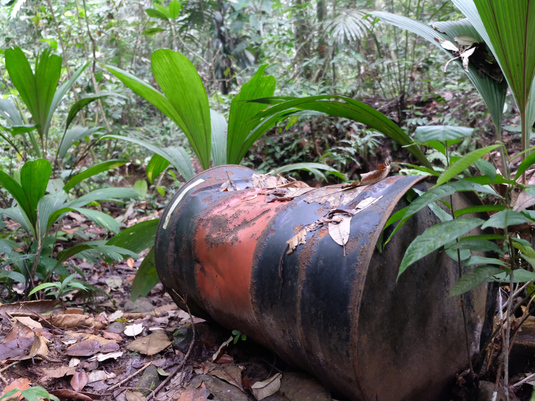
Texaco barrel in the forest, © Theresa Leisgang
Like a tiny mushroom, hope is growing in the once-lush rain forest of the Amazon in northeastern Ecuador: bioremediation as a solution to the extensive environmental contamination. It is a hazardous hope, however. Hazardous because it relates to a dangerous place—over the course of more than 50 years of intense settler colonization and careless hydrocarbon exploitation, the region has turned into a vast agricultural landscape nourished by polluted soils and rivers. Just as the tropical landscape has been deteriorating since the advent of oil production in the 1960s, so too is the health of the local population. Settlers, indigenous people, and wild and domestic animals are suffering from the contamination caused by decades-old oil pits, ongoing gas flaring, and almost weekly oil spills. Many of the local population’s stories are tragic: lost family members, malformed babies, and no means to overcome the contamination that pervades daily life.
Another reason that this tiny hope can be framed as hazardous is that hope itself is under siege. The local population has been deceived repeatedly—with blatant lies denying the dangers of oil production, as well as with broken promises to halt pollution. Nonetheless, cautious hope remains that the environmental contamination might be remediated, making it possible for the inhabitants of the Ecuadorian Amazon to lead a dignified life once more.
Here, somewhere between the oil towns of Lago Agrio, Sacha, and Shushufindi, the former epicenters of Texaco’s operations in Ecuador, I conducted five months of fieldwork in the first half of 2018 for my PhD thesis on the environmental history of the Amazon. I did not only contribute to documenting the impacts and transformations of oil production, but I was also looking for glimmers of hope—however hazardous they might be. In the process, a fundamental question presented itself. Given that the oil industry has been imposed from outside in the form of the national government and transnational companies like Texaco, shouldn’t relief and a proper cleanup also come from outside?
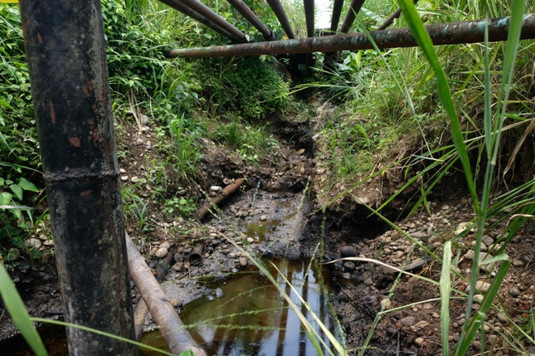
Site of a recent oil spill due to a corroded pipeline just north of Lago Agrio. A family’s home lies just a few meters away. ©Maximilian Feichtner.
How to Clean Up the Soil
The large-scale contamination of bodies of water, soils, forests, and the air as a result of industrialization and resource extraction is one of the major environmental challenges humanity is facing in the twenty-first century. This is as true for the many Superfund sites harboring hazardous waste in the US as it is for the Ecuadorian Amazon forest. However, the environmental (and consequently social) damage caused by the transnational oil industry in the small Latin American country goes far beyond pollution from oil spills and (toxic) waste dumps. The ecological relations within the tropical ecosystems of streams, lagoons, and swamps have been altered: deforestation has led to erosion and the sedimentation of rivers, noise has driven away animals, and hunting has decimated wildlife and reduced biodiversity—a whole range of detrimental environmental processes that reinforce one another and have fundamental impacts on local communities and their subsistence. The cultural and social consequences include the expropriation of territories, the disintegration of indigenous communities, and a high percentage of child mortality. Despite the country’s wealth in this area, which derives from the fossil resources found beneath the lush green forest cover, the local population is left in poverty. The lack of infrastructure is a manifestation of insufficient care for and attention to these communities. Recent estimations of cancer rates for the oil region reveal shocking results: in every four families there is at least one cancer patient. The state of human health forms an alarming backdrop to the oil region, painting a bleak picture for more-than-human life in the Amazon forest as well.
It therefore does not seem far-fetched to demand that the state and the oil multinationals who have profited from this extraction contribute to the remediation of the environmental contamination, reparations for social damages, and the restoration of better living conditions. The Ecuadorean environmental activist community is vigorously pushing for actions and policies to restore the rights of the affected, to improve their situation, and to prevent the repetition of these aggressions. A tentative consciousness about the need for such reparation and remediation has slowly been emerging since the 1990s. Some steps were taken at the time, but has the situation improved? Is there any hope for the local population to one day live a dignified life in a healthy environment?
Common remediation practices for crude oil contamination include the use of chemical solvents or incineration. However, while these appear to be effective in some cases, they are neither desirable (simply replacing one kind of pollution with another) nor feasible at a regional scale in an area where people physically live on contaminated soil. The Ecuadorian government and local NGOs have opted for bioremediation instead, which harnesses the potential of microorganisms like bacteria or fungi to naturally degrade hydrocarbons. In the 1990s, public and private companies, sometimes in collaboration with national universities, started to research decontamination and took some first steps towards treating oil-polluted soils and sediments in the Ecuadorian Amazon.
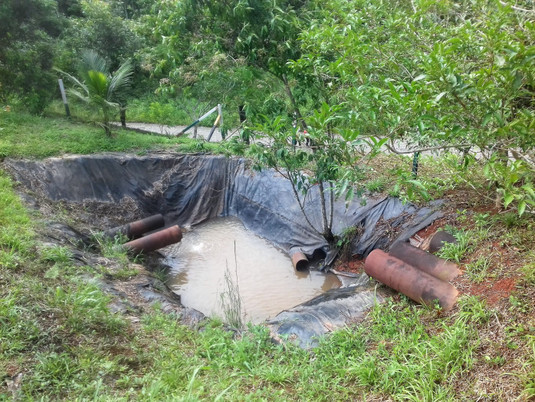
Drainage basin at the bioremediation plant, used to discharge contaminated water into the nearby stream ©Maximilian Feichtner.
The process generally involves clearing a contaminated site of vegetation, before the soil is then dug up and transported to treatment sites. One of the main ex-situ bioremediation techniques involves using bacteria for composting, where large piles of soil are aerated with machinery. The supply of oxygen is essential in order to keep the naturally occurring bacteria alive and well. These organisms are well adapted to their hydrocarbon environment—in Texaco’s open-oil and waste pits they have had about 50 years to do so. These kinds of bacteria are cultivated and applied to the compost piles, where they disintegrate the hydrocarbon content. The second bioremediation technique, landfarming, involves the biodegradation of the pollutants with the same bacteria in very flat piles that don’t require active aeration. Once treated, the soil is returned to its original site and the area is either reforested or replanted with crops like cacao or coffee, depending on its previous use (presentation of the Amazonia Viva project, April 2018).
Unfulfilled Promises … and Worse
Promising and necessary as it seems, the remediation of oil-polluted soils in Ecuador has been a shabby business if not an outright deception. Most prominently, Texaco undertook a big remediation “effort” in the mid-1990s to clean up part of their 30-year legacy of rather profitable contamination in the northeastern part of the Ecuadorian Amazon. Their efforts consisted mainly of covering up oil pits with a layer of soil. The recurrent rains kept washing pollutants from these sites into the surrounding area where, a few years later, unsuspecting settlers would build their houses—a situation reminiscent of the Love Canal near Niagara falls, a former chemical disposal site whose hazardous waste affected an entire local community.
In the 2000s, things became even more twisted: bioremediation turned into a veritable business, with a few private companies being awarded profitable contracts to clean up spills. What resulted, however, was a rise in the sabotage of oil pipelines: intentional spills combined with corruption in politics and economy led to the lucrative awarding of remediation contracts often worth millions of dollars. Consequently, this kind of collaboration was suspended and the public oil company Petroecuador and its subsidiary Petroamazonas relied on their own bioremediation programs.
The Amazonía Viva Project: A Step Forward
During an interview at Petroamazonas’s headquarters in Quito, the head of the Amazonía Viva program proudly insisted on having reached a major milestone in the remediation history of the country at the end of 2017. In only four years, she told me, the project had remediated one million cubic meters of contaminated soil and about 750 sources of pollution. Their success story also includes the active hiring of a local workforce at the remediation sites in the Amazon.
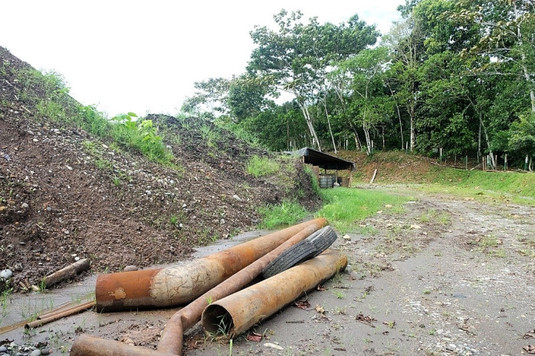
Piles of contaminated soil at a bioremediation plant of the Amazonía Viva project. © Theresa Leisgang.
But on site, the picture is quite different. Imagine a huge, leveled area next to an abandoned oil well, covered with dozens of piles of oil-trenched soil, each about 3 meters high and approximately 30 meters long. A handful of workers walks around, filling buckets with bacteria-treated liquid from a big tank—the stench is overwhelming. Everything is quiet. Hesitantly, the workers answer a few questions, revealing that the piles of compost are only turned—and thereby aerated—about every three months when tractors and excavators are brought in. Since the project does not seem to comply with the aeration standards outlined in a Petroecuador manual from 2010, it is questionable whether the aerobic bacteria can even survive under these circumstances and ensure the degradation of hydrocarbons on such a large scale. Additionally, the drainage system is very basic, consisting mainly of two little basins to collect the contaminated rainwater that has washed through the piles of soil. Oil residues swim on the surface of these basins and are supposedly recovered. Without further treatment to filter out heavy metals and other pollutants, the wastewater runs into the nearby stream, a local activist tells me.
While this centralized, top-down, large-scale remediation effort is certainly a big step forward in decontaminating the area, my observations on site show that these efforts are neither comprehensive nor do they involve the local communities. This calls into question whether oil companies are the right actors to carry out remediation in the first place: “[I]n a thorny issue like contamination, it does not seem appropriate for the same actor to be the banker, judge, accomplice, and entrepreneur, etc. It seems a mistake to give the job of clean-up and oversight to the polluter,” say researchers Cuvi and Bejarano.
Medicine for the Soil
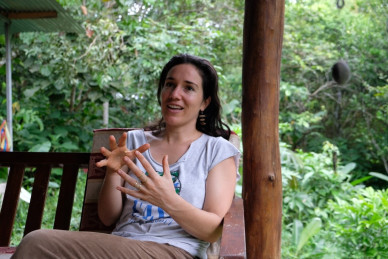
Biologist Alexis Gropper gives a compelling introduction to bioremediation right next to her fungi lab in Lago Agrio. ©Theresa Leisgang.
Given the oil company’s active but inadequate attempts, it is up to NGOs and committed locals to create inclusive bottom-up solutions that help regenerate the environment they live in. One such local is biologist and mushroom enthusiast Alexis Gropper, who lives at the outskirts of Lago Agrio. Right next to an abandoned oil well, her husband’s family reforested a former cattle ranch that is now also home to her fungi lab and cultivation station. Oyster mushrooms (Pleurotus ostreatus), Reishi (Ganoderma Lucidum), and Turkey Tale (Trametes versicolor) are three types of “petrophile” fungi that she identified thriving on and around oil pits in the region where they had, over the course of decades, adapted to a crude-oil diet. These fungi not only have medicinal properties, they also create enzymes that split up hydrocarbons.
Given the oil company’s active but inadequate attempts, it is up to NGOs and committed locals to create inclusive bottom-up solutions that help regenerate the environment they live in. One such local is biologist and mushroom enthusiast Alexis Gropper, who lives at the outskirts of Lago Agrio. Right next to an abandoned oil well, her husband’s family reforested a former cattle ranch that is now also home to her fungi lab and cultivation station. Oyster mushrooms (Pleurotus ostreatus), Reishi (Ganoderma Lucidum), and Turkey Tale (Trametes versicolor) are three types of “petrophile” fungi that she identified thriving on and around oil pits in the region where they had, over the course of decades, adapted to a crude-oil diet. These fungi not only have medicinal properties, they also create enzymes that split up hydrocarbons.
What distinguishes them from bacteria and makes them essential for a holistic bioremediation process is their ability to accumulate heavy metals, such as mercury, in their fruits. Once absorbed and stored by the mushrooms (or different kinds of plants), the heavy metals can be “harvested,” removed from the contaminated site, and then treated as hazardous waste. One option is incineration and subsequent storage in a safe place, which could be as simple sealing them in road asphalt. However, Alexis Gropper told me during a lab visit in February 2018: “For now, bioremediation methods using bacteria and plants have proved to be easier to propagate on larger scales, and are very efficient in the decomposition of chemicals and bioaccumulation of heavy metals if and when the procedures are implemented correctly.” Her vision to help the forest recuperate involves fostering symbiotic relationships between plants, fungi, and bacteria.
That these symbiotic relationships also need to include the human population of the area— indigenous and settler communities—is evident to the local NGO UDAPT. As a grassroots organization, UDAPT envisions an on-site, community-based, empowering way of treating soils and water. Members want the local population to identify with the remediation process and additionally create benefits for the local economy of this structurally marginalized region.
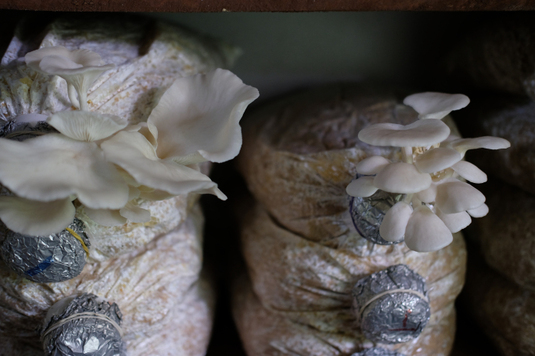
Thriving Oyster mushrooms in Alexis Gropper’s lab which, in this case, are grown for consumption and hence free from heavy metals and other pollutants. ©Theresa Leisgang.
In April this year, UDAPT made great progress by signing a joint agreement with the bacteriologist Robert Rawson and the environmental NGO CoRenewal to design and implement the Bioremediation Investigations and Capacity Building Project in the affected provinces of Sucumbíos and Orellana. This project aims to establish a comprehensive socioenvironmental recuperation plan and includes an open-ended bioremediation investigation, as well as a training and certification process that will be carried out for those people residing in the affected area.
Rawson will make his patented microbial technology—a blend of beneficial, nontoxic Pseudomonas and Bacillus bacteria species—available to the inhabitants of the Amazon. The process of incubating and applying the bacteria is highly labor intensive and hence presents considerable job opportunities when it comes to large-scale application. Furthermore, this bioremediation technology not only favors labor over capital, but also favors local communities as they can adapt these methods to their own environment, as Alexis Gropper points out.
This remediation effort will be carried out in close cooperation with the affected communities and is open to all kinds of symbiotic relationships and solutions. The benefits are numerous: proper decontamination will decrease adverse health impacts of living in the area; the creation of employment opportunities that are not dependent on the petroleum industry will provide social, cultural, and economic growth for the northern Amazon region of Ecuador. While this is still a tentative hope, it is certainly less hazardous than it has been in the past. Remediation cannot be based on a technological, chemical fix alone, but has to grow out of a community-based, symbiotic effort. However, the challenge of cleaning up five decades of a contaminated past is enormous—hopefully, in time, it will be possible to recreate a healthy tropical environment that nourishes, rather than poisons, its inhabitants.







